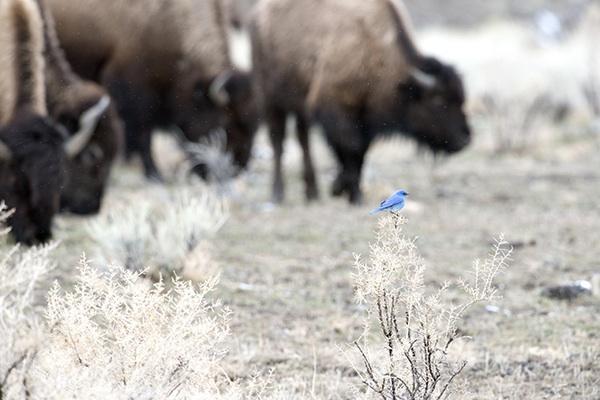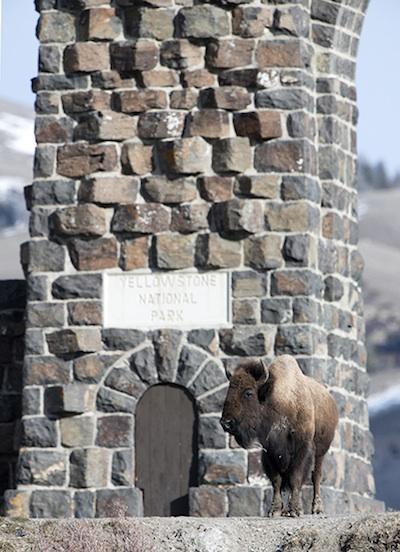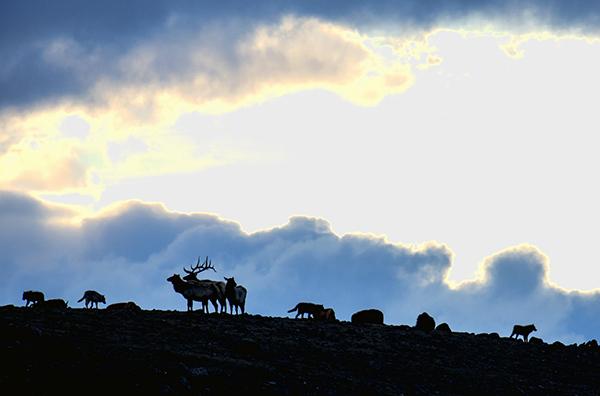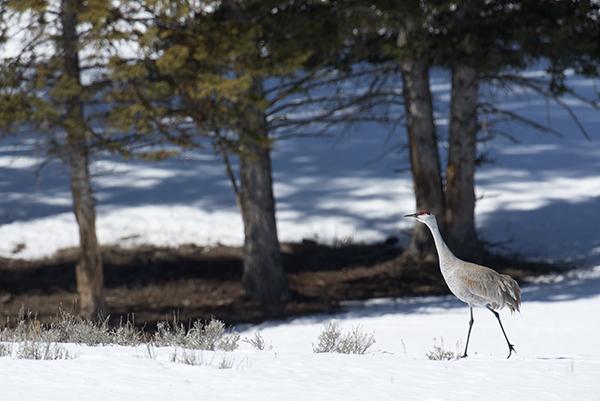
Bluebirds and bison. It must be spring in Yellowstone/Deby Dixon
The first bright spot of spring in Yellowstone National Park is the mountain bluebird when it returns to Lamar Valley where they come to feast upon the newly hatched caddisfly that is hopping around on top of the snow near the Lamar River.
The beautiful blue of that bird against white snow is a welcome and breathtaking sight after a long, drab winter driving back and forth on one road that leads from the North Entrance to the Northeast Entrance of the park, looking for something beautiful and unusual to capture with my long lens.
Those bright spots of spring, have been followed by many other birds, such as the osprey, red-tail hawk, Sandhill crane, American robin and others, all arriving to announce that spring is here. Yet, this morning I was out in Lamar Valley watching a couple of wolves sleep near five bull elk that were also resting, in 10-degree weather with bright sunshine. Actually, it was my lucky morning because the deep snow in the valley had frozen hard enough for me to walk across the valley, and I love walking on snow.
But, what does all of that have to do with photography? The landscape and the birds.

At the Roosevelt Arch./Deby Dixon
When I first began photographing wildlife, with a Nikon 80-400mm 4.5-5.6 (very slow) lens, I always dreamt about the closeup. The reflection in the eye, the texture of the fur or feathers and the eye lashes on the birds. I actually did not know that birds had eye lashes until my first close-up. But, at 400mm I could never get close enough or, if close, the sharp enough images.
I have had my 500mm Nikon lens, with my Nikon D800, for nearly a year now and vividly remember those dreams of finally getting the close-ups of the animals. And, to be sure, I have succeeded in getting many nice portraits of the various wildlife in Yellowstone, but now it is time for me to step back and put that animal into the landscape.
Standing back and including the animals in the landscape, in an attractive way, is not as easy as it seems. First of all, it is difficult to get rid of the impulse for the close-up shot and second of all, the landscape shots take much more planning and work to get into the right position and include the right elements without having too many objects that distract from the main subject.
One day, while at Old Faithful, I unpacked my long forgotten Nikon 80-200mm 2.8, (an oldie but a goodie) and attached it to my D800, because I planned to do a lot of walking and would not be carrying the big lens. The D800 has a large sensor and so, I reasoned, if the animals were close at all, I could always crop and still have decent images. Well, the D800 and the 80-200 turned out to be a dream team of sharpness and clarity and I was hooked from the very first shot. Which was good because that lens became stuck on the D800 when the lens release failed.
Before long I found myself shooting most of my wildlife images with the shorter lens and began placing the animals into the beautiful, snow covered landscape instead of them dominating the scenery.
And, so, when the bluebirds came to town, they didn't look as far away as they had the previous year when I was trying for some close-ups of those beautiful blue feathers, and I began experimenting with different compositions that placed them in the environment.
One of the first things that I noticed was that shooting from a greater distance makes it much easier to capture the animals or birds interacting with one another, or capturing the birds in flight.

Wolves and elk at peace./Deby Dixon
The main thing with shooting wildlife, once you have the composition, interaction and environment that you want, is focus. Without sharp focus of the eye, your image is no good. I tend to move my focal point into the right lower to middle third of the frame, which makes it more difficult to get that perfect focus but gives me a great composition straight out of the camera.
For a more reliable focus, many photographers put their focal point dead center, and it works well for them but for the final product, you don't normally want your subject in the center, and so cropping becomes necessary, and that often cuts out interesting aspects of your image. The only time I really go for center focus and rely on it is when the subject is moving quickly, such as a flying bird. Other than that I try to compose in camera rather than on the computer. And, always, always, I try to place the focal point over the animal's eye.
So, next time you see a beautiful animal that you want to shoot with your camera, stand back and look at the surroundings and compose without cutting off the top of an interesting tree. Try adding a mountain and some sky, or maybe some bison behind a bluebird. Think about the lines of the landscape and which way they move in relationship to your subject.
Play with the angles of the sun and the direction of the shadows. Look closely and find the perfect place for your animal to stand and then wait, watch, and hope that it wanders that way. For, once you have decided on the perfect composition, most others fall short of your ideal. If you don't get the shot right away, don't give up, keep looking for the opportunities to make your photos more unique and interesting.
Because, once you have that close-up shot that allows you to count the nostril hairs of an animal, then it is time to stretch your skills and imagination - the skills that allow you to see spring when the snow is still falling.

Sandhill on the march./Deby Dixon



Comments
Wolves and elk at peace.
Y'gotta love it. What a wonderful photo.
The marching sandhill looks a lot like one of my neighbors on her way out to the mailboxes every morning.
Thanks again, Deby, for some fine pictures and good tips.
I love the colors of the bluebird/bison image.
Good article. Wolves and elk lying together ???? :)
I do photos in Glacier NP. I try to get the animals with scenery in the background so people know it's in Glacier, not somebody's back yard. Sometimes it works, but the creatures don't always cooperate.